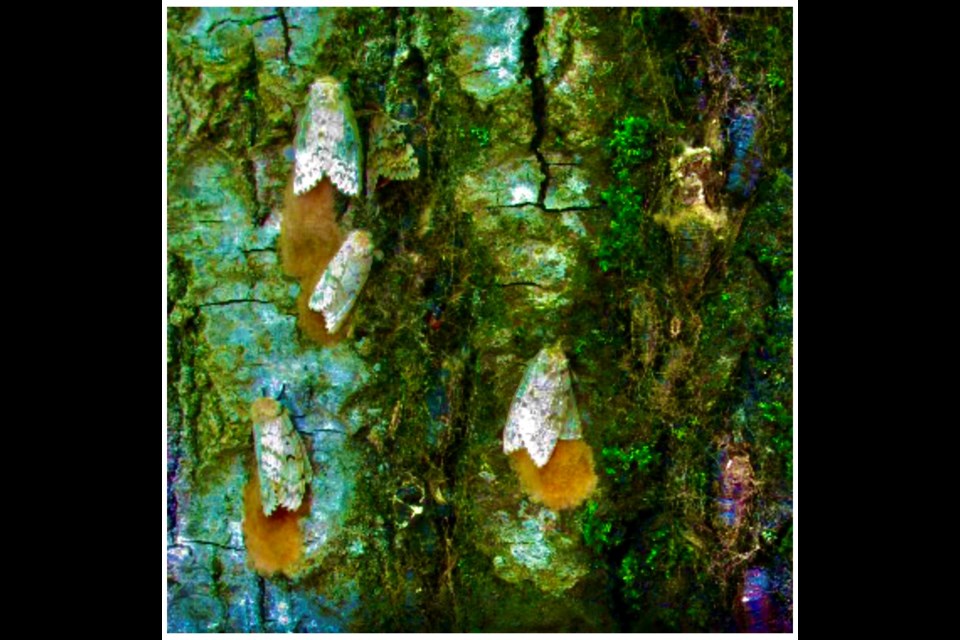Butter knives and spoons have been enlisted in the region's ongoing battle with gypsy moths.
The next step in stemming the infestation, between now and next April, is to scrape egg masses off tree surfaces and drop them into soapy water for two days, which destroys the bugs.
Dave Friary, Barrie's operations director, says this could play a significant role in limiting next year’s infestation.
“(It’s) very important. Each egg mass can contain 100 to 1,000 eggs,” he said. “Many residents have been seen removing egg masses off of both private and public trees, which we appreciate.”
Friary says homeowners should only scrape egg masses from a comfortable height.
“Higher masses of eggs in the crown (of the tree) can be controlled safely with banding in the spring,” he said.
The egg masses are thumb-sized and any given tree can have a dozen or more. They can be scraped off with a plastic scraper, so the tree isn’t damaged, as well as spoons and butter knives.
The city recommends wearing gloves and safety glasses for protection, then placing a container below the egg mass. The eggs then go into a bucket of soapy water, and are left there for two days to kill them.
This is also important because even a cold Canadian winter, with large stretches of frigid temperatures, might not get rid of the pests.
“We would need extended days at minus-20 Celsius to kill off wintering larvae, but (it’s) not a sure thing,” Friary said.
Now being called LDD (lymantria dispar dispar) moths, the insects are invasive bugs which feed on tree leaves, destroying tree growth and taking away trees’ ability to produce new leaves.
The city’s urban forestry page says the species prefers oak, birch, aspen, sugar maple, American beech, eastern white pine and Colorado blue spruce trees.
The European LDD moth has a seven- to 10-year cycle and this year was expected to see a peak in its population.
Last spring, council instructed city staff to investigate the feasibility of aerial spraying or the use of pheromone traps to help prevent future moth infestations, including the costs, and report back as part of next year’s budget process.
Aerial spraying of an insecticide could be very expensive for the city, and there could be mitigating factors — such as rain on the days following the spraying. There would need to be consultation with Barrie’s municipal neighbours if the entire city was sprayed with a pesticide.
Another approach would be spraying the city’s own woodlots and not the residential areas.
Pheromone traps are baited with a synthetic lure, which mimics the pheromone released by the female LDD moth to attract the male. When males enter the trap looking for a female producing the pheromone, they get stuck. But most see pheromone traps as a way of determining the extent of the moth problem, rather than a solution.
Jamie Rodgers, the city’s acting supervisor of parks and forestry operations, says there are measures are in place to track this year’s infestation.
“We have completed our 2021 LDD moth defoliation survey and we are reviewing the results, comparing them from last season,” he said. “Also, our fall egg-mass survey will be conducted and made public in October-ish, with an action plan to be put in motion.”
Native to Europe, the LDD moths were first detected in Ontario in 1969, but widespread defoliation did not occur until 1981.
The province says established populations now exist south of a line from Sault Ste. Marie, east to North Bay and Mattawa. There’s a separate infestation in New Liskeard.
The pests spend winter in the egg stage, often on the bark of trees. In spring, the eggs hatch and the larvae or caterpillars feed on the trees’ new leaves. This first happens mainly during the day, but as the caterpillars mature they eat at night. Feeding is completed in July. The male moths are light brown with slender bodies, while females are white with heavy bodies.
